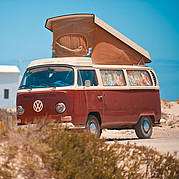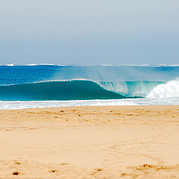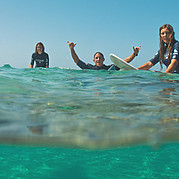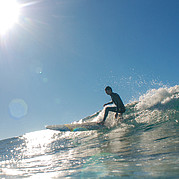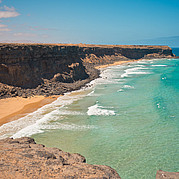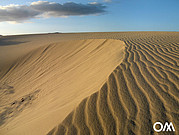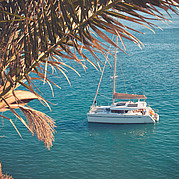Surf spot Playa Blanca on Fuerteventura
Playa Blanca beach is actually not in the south of Fuerteventura, but in the middle of the island, on the east coast.
Playa Blanca belongs to the municipality of Puerto del Rosario. That is the capital of Fuerteventura. This surf beach probably rarely appears in any surf spot lists or in pictures of the most beautiful beaches in Fuerteventura.
Nevertheless, most people have passed by this beach many times. Namely on the way to or from the airport of Fuerteventura. "Why is this beach getting its own post here?" you might be asking yourself now. The waves on the west coast of Fuerteventura are too strong on some days for first attempts at surfing green waves. Advanced surfers will still have fun. But surfers who can't yet paddle out behind the breaking waves need a lot of power and strength to surf unbroken waves. Very often there are small, easy waves at Playa Blanca. These are perfect for the first attempts at surfing unbroken green waves.
Directions to Playa Blanca in Fuerteventura
Getting to Playa Blanca is super easy and you don't need a navigation system. Just drive in the direction of the airport. If the airport is not signposted, then drive towards Puerto del Rosario.
If you are coming from the south of the island, follow the motorway north, which becomes a single-lane road after Costa Calma. You will pass various places, first La Lajita, then Tarajalejo, later Gran Tarajal and finally Castillo, which is also called Caleta de Fuste. From there it is not far to the airport. From the airport, the road becomes a two-lane motorway again. Follow the motorway for a few hundred metres towards Puerto del Rosario. After a left-hand bend, you will see the capital of Fuerteventura in front of you. To the right of the road, directly by the sea, is an old hotel whose architecture is somewhat similar to that of a fort from a Wild West film or a small fortress. Directly behind it begins the beach of Puerto del Rosario, called Playa Blanca.
At the end of the bend, you can turn right off the motorway. Take this exit and you will come to a large natural car park. Here you can park the car. There is a dirt road behind the beach where it is not uncommon for cars from other surf schools to park. However, it is not uncommon for cars parked there to be ticketed by the local police. Usually with the advice to use the car park next time.
The waves of Playa Blanca in Fuerteventura
The waves of the beach often shift with the position of the sandbanks. As with all beaches, the position and shape of the sandbanks can always change after strong storms with powerful waves. Nevertheless, it is usually the case that the waves of Playa Blanca always break in similar places. There are often waves near the car park in front of the hotel, at the southern end of the bay. These waves are more for advanced surfers, because here the bottom can be a bit rocky and a current pulls surfers out to sea.
In the middle of the bay, more waves also break on at least two sandbanks. Often there is a sandbank with good waves at the height of the large beach villa. In general, the waves of Playa Blanca are gentler and less powerful than comparable waves on the west coast of Fuerteventura.
In what conditions do you surf at Playa Blanca in Fuerteventura?
Playa Blanca beach is located on the east coast of Fuerteventura. The powerful low pressure areas that generate the waves on the west coast of the island have no influence on the waves on the east coast. Most of the waves on the east side of the island are generated by local winds, mainly thanks to the constantly prevailing trade winds.
The trade wind comes from the north-east and hits the east coast of Fuerteventura diagonally parallel. Unlike the beaches on the east coast in the south of Fuerteventura, the wind at Playa Blanca is not offshore, but onshore. On the other hand, there are more frequent wind waves here than at comparable beaches on the east coast in the south of Fuerteventura. For waves to form at Playa Blanca, the wind must come from a north-easterly direction. If the wind is from the west or very north, no waves break at Playa Blanca.
Thanks to the evenly sloping beach, you can surf in Playa Blanca at all tides. White water waves break a little better at low tide and green waves at high tide. But even at different tides, there are still plenty of white water or unbroken waves to practice on.
What to look out for when surfing at Playa Blanca on Fuerteventura
Playa Blanca, like all beaches on the east coast, is comparatively safe. Not only are the waves here much less powerful, but the currents also carry less water. They are therefore less powerful than comparable currents on the beaches of the west coast of the island. Nevertheless, there are some small things to watch out for in Playa Blanca on Fuerteventura.
For example, at the southern end of the bay in front of the hotel, there is a kind of headland made of thick stones. Here, there is almost always a current that pulls out to sea. On days with strong waves, this current can also pull surfers further south out of the bay and in front of the stones. At this southern end of the bay, there may also be some rocks at the bottom due to the persistent current. Advanced surfers like the southern end of the beach. Inexperienced surfers surfing Playa Blanca for the first time should surf the waves further in the middle.
Although the waves on Fuerteventura's east coast always break more gently than the waves on the west coast, the waves in Playa Blanca can also become more powerful during strong storms. So you shouldn't underestimate the waves of Playa Blanca if they are bigger than shoulder-high to head-high.
What most surfers don't know then is the high frequency of the waves. Waves created by the local, north-easterly trade winds do not travel thousands of kilometres across the open Atlantic. On the long way through the Atlantic, the waves normally arrange themselves into wave groups. This also increases the distance between the waves. This distance is also called wave period and is measured in seconds. The wave period on the east coast is smaller. This leads to the impression that waves are rolling in continuously when there are larger waves on the east coast.
